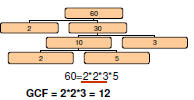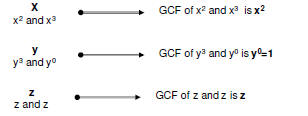Factoring Polynomials
Finding GCF (Greatest Common Factor)
•the largest natural number that divides all given numbers evenly
Find the GCF of 24 and 60
| List Factors | Prime Factorization |
| Factors of 24: |  |
| 1 2 3 4 6 8 12 24 | |
| Factors of 60: |  |
| 1 2 3 4 5 6 10 12 15 20 30 60 |
Finding GCF Of Variables
Find the GCF of x2y3z and x3z
Consider each variable that exists in each Monomial

Therefore, GCF of x2y3z and x3z is x2*1*z = x2z
The simplest method of factoring a polynomial is to factor
out
the greatest common factor (GCF) of each term.
Example: Factor 18x3 + 60x.
| GCF of 18 and 60 = 6 | Determine GCF of the coefficients of each term. |
| GCF x3 and x = x | Determine GCF of the variables in each term. |
| GCF = 6x | The GCF of the polynomial is the product of the GCF’s found above |
 |
Factored form GCF ->*
 |
 |
Rewrite and Simplify within the |
 |
parentheses. |
| Check the answer by multiplication. |  |
The simplest method of factoring a polynomial is to factor
out
the greatest common factor (GCF) of each term.
Example: Factor 24x2y + 60x3
| GCF of 24 and 60 = 12 | Determine GCF of the coefficients of each term. |
| GCF x2y and x3 = x2 | Determine GCF of the variables in each term. |
| GCF = 12x2 | The GCF of the polynomial is the product of the GCF’s found above. |
 |
Factored form GCF -> * |
 |
Rewrite and Simplify within the parentheses. |
 |
|
| Check the answer by multiplication. |  |
The simplest method of factoring a polynomial is to factor
out
the greatest common factor (GCF) of each term.
Example: Factor 4x2 -12x+ 20.
| GCF of 4, 12 and 20 = 4 | Determine GCF of the coefficients of each term. |
| GCF x2, x , 0 = N/A | Determine GCF of the variables in each term. |
| GCF = 4 | The GCF of the polynomial is the product of the GCF’s found above. |
 |
Factored form GCF ->* |
 |
Simplify. |
 |
|
| Check the answer by multiplication. |  |
A common binomial factor can be factored out of certain
expressions.
Example: Factor the expression 5(x + 1) – y(x + 1).
5(x + 1) – y(x + 1) = (5 – y)(x + 1)
(5 – y)(x + 1) = 5(x + 1) – y(x + 1) Check.
Some polynomials can be factored by grouping terms to produce
a common binomial factor.
Examples: 1. Factor xy + 2y + 7x + 14.
| xy + 2y + 7x + 14. | = (xy + 2y) + (7x + 14). | Group terms. |
| = y(x + 2) + 7(x + 2) | Factor each pair of terms. | |
| = (x + 2)(y + 7) | Factor out the common binomial. |
2. Factor 6x3 - 8x2 + 3xy - 4y.
| 6x3 - 8x2 + 3xy - 4y. | = (6x3 - 8x2)+ (3xy - 4y). | Group terms. |
| = 2x2(3x – 4) + y(3x – 4) | Factor. | |
| = (2x2 + y)(3x – 4) |
Some polynomials can be factored by grouping terms to produce
a common binomial factor.
Examples: 3. Factor 2xy + 3y – 4x – 6.
| 2xy + 3y – 4x – 6 | = (2xy + 3y) – (4x + 6) | Group terms. |
| = (2x + 3)y – (2x + 3)2 | Factor each pair of terms. | |
| = (2x + 3)(y – 2) | Factor out the common binomial. |
4. Factor 2a2 + 3bc – 2ab – 3ac.
| 2a2 + 3bc – 2ab – 3ac | = 2a2 – 2ab – 3ac + 3abc | Rearrange terms. |
| = (2a2 – 2ab) – (3ac + 3bc) | Group terms. | |
| = 2a(a – b) – 3c(a – b) | Factor. | |
| = 2a(a – b) – 3c(a – b) | Factor. | |
| = (2a – 3c)(a – b) |


